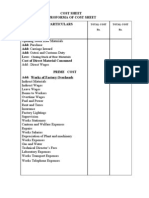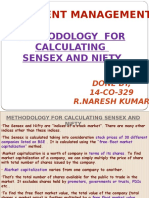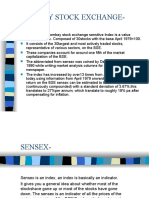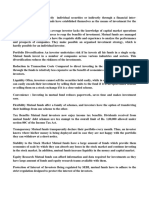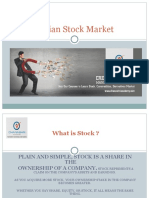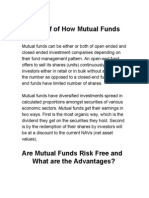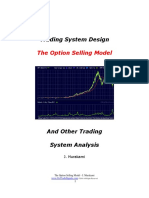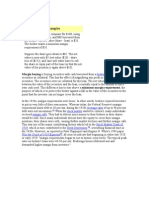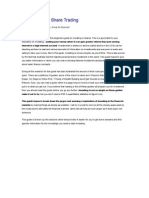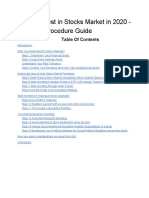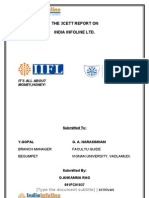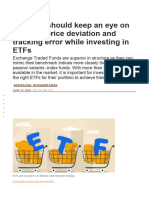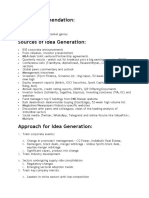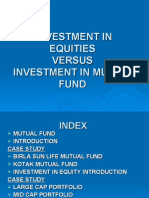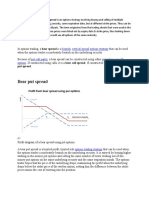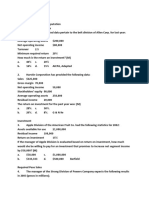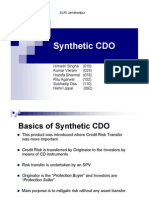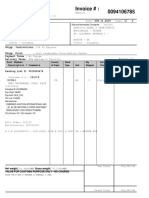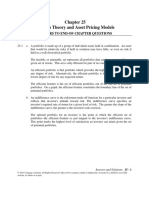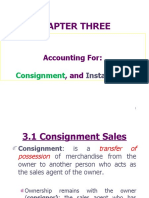Stock Market Indicies Assingment
Stock Market Indicies Assingment
Uploaded by
tullipsCopyright:
Available Formats
Stock Market Indicies Assingment
Stock Market Indicies Assingment
Uploaded by
tullipsCopyright
Available Formats
Share this document
Did you find this document useful?
Is this content inappropriate?
Copyright:
Available Formats
Stock Market Indicies Assingment
Stock Market Indicies Assingment
Uploaded by
tullipsCopyright:
Available Formats
STOCK MARKET INDICES PREVALENT IN INDIA
Stock Market is a place where the stocks of a listed company are traded. Stock market is a marketplace for share trading, incorporates of trade stocks and their derivatives. The term 'stock market' is actually an idea for the operation which makes trading of company stocks possible. A single figure that sums up the overall performance of the market on a daily basis is the Stock Index. A good Stock Index captures the movement of the well diversified and highly liquid stocks. For a lay man it is the pulse rate of the economy. Index movements reflect the changing expectations of the stock market about future dividends of the corporate sector. The index is calculated by finding the weighted average of the prices of the most actively traded companies in the market, where the weights are generally in proportion to the market capitalization of the company. Investing in the stock market is one way of generating the high returns on offer but for some people it is not the preferred method. If you're one of the people that do not want to follow continually changing shape prices for individual companies, indices stock may be the option for you. Investing in indices stock means you agree to accept the returns on offer based on the entire stock market rather than individual companies. For example, instead of investing in one particular company, you would invest in a broader classification of companies. Microsoft is a well known global company in the technology sector and it is a commonly held stock in portfolios around the world. If you wanted to invest in indices stock rather than in the stock market itself, you would choose indices which include Microsoft in it. Such as broad technology indices which might include over 100 companies. The returns you generate are then based on the performance of all the companies in that sector rather than Microsoft itself. This lowers the risk of investing in just one particular company which has the potential to perform poorly because of market conditions, investor preferences, or external circumstances which you are unable to predict. By investing in indices stock you lower your exposure to the inherent risks associated with individual companies and instead gain returns generated by a particular sector. Indices stock can also take the form of a broader stock market indices which is based on is based on the entire stock market. The returns are generally lower than those that could be achieved through an individual company but the risks are also lower.
Types of Indices available:Broad-Market Index: This consists of all the large, liquid stocks of the country and becomes the benchmark for the entire capital market of the country. An example for this is the S&P CNX 500. Specialized Index: We can either have Industry or Sector specific Index for any particular sector of the economy which then serves as the benchmark for that particular industry or we can have an Index for the highly liquid stocks. Taking an example for an industry specific index we have the S&P Banking Index which is a capitalization-weighted index of 26 domestic equities traded on
the New York Stock Exchange and NASDAQ, The stocks in the Index are high-capitalization stocks representing a sector of the S&P 500. Similarly, The S&P CNX Nifty is a relevant example for an index composed of highly liquid stocks
Stock Exchanges in india BSE and NSE
There are two national stock exchanges in the country, the Bombay Stock Exchange(BSE) and the National Stock Exchange (NSE) . BombayStockExchange(BSE) The BSE is the oldest stock exchange in the country, established in 1875. It was structured as a membership based firm, an Association of Persons. It is now a demutualised and corporatised entity, falling in line with Sebi's guidelines on demutualization of stock exchanges. The purpose is to separate ownership and management to prevent any conflicts of interest. The BSE is managed by a Board of Directors, comprising professionals, trading member representatives and has a managing director too. The Board formulates larger policy issues and exercises overall control. The managing director takes care of daily operations. The exchange is present in 417 cities in India. BSE Indices The BSE maintains several stock indices that are popular among investors. The following are some of the closely watched indices. BSE Sensitive Index (BSE-30) BSE National Index (BSE-100) or BSE 100 BSE-200 and the Dollex BSE-500 Apart from these, there are a host of other indices which focus on certain sections of stocks like small cap and mid-cap stocks. Then there are various other indices that are focused on sectors. These indices are updated on a real time basis in market hours. The most popular index is the BSE Sensitive Index, the Sensex
SENSEX Calculation Methodology
The Sensex has a very important function. The Sensex is supposed to be an indicator of the stocks in the BSE. It is supposed to show whether the stocks are generally going up, or generally going down. To show this accurately, the Sensex is calculated taking into consideration stock prices of 30 different BSE listed companies. It is calculated using the free-float market capitalization method. This is a world wide accepted method as one of the best methods for calculating a stock market index. Please note: The method used for calculating the Sensex and the 30 companies that are taken into consideration are changed from time to time. This is done to make the Sensex an accurate index and so that it represents the BSE stocks properly. To really understand how the Sensex is calculated, you simply need to understand what the term free-float market capitalization means. (As we said earlier, the Sensex is calculated on basis of the free-float market capitalization method) But, before we understand what free-float market capitalization means, you first need to understand what market capitalization means. Market cap or market capitalization is simply the worth of a company in terms of its shares! To put it in a simple way, if you were to buy all the shares of a particular company, what is the amount you would have to pay? That amount is called the market capitalization! Depending on the value of the market cap, the company will either be a mid-cap or large-cap or small-cap company!
FREE FLOAT CAPITALIZATION
Many different types of investors hold the shares of a company. The Govt. may hold some of the shares. Some of the shares may be held by the founders or directors of the company. Some of the shares may be held by the FDIs etc. etc! Now, only the open market shares that are free for trading by anyone, are called the free-float shares. When we are calculating the Sensex, we are interested in thesefreefloatshares. A particular company, may have certain shares in the open market and certain shares that are not available for trading in the open market. According the BSE, any shares that DO NOT fall under the following criteria, can be considered to be open market shares: Holdings by founders/directors/ acquirers which has control element
y y y y y y y
Holdings by persons/ bodies with "controlling interest" Government holding as promoter/acquirer Holdings through the FDI Route Strategic stakes by private corporate bodies/ individuals Equity held by associate/group companies (cross-holdings) Equity held by employee welfare trusts Locked-in shares and shares which would not be sold in the open market in normal course.
A company has to submit a complete report about who has how many of the companys shares to the BSE. On the basis of this, the BSE will decide the freefloat factor of the company. The free-float factor is a very valuable number! If you multiply the "free-float factor" with the market cap of that company, you will get the free-float market cap which is the value of the shares of the company in the open market! A simple way to understand the free-float market cap would be, the total cost of buying all the shares in the open market! So, having understood what the free float market cap is, now what? How do you find out the value of the Sensex at a particular point? Well, its pretty simple. First: Find out the free-float market cap of all the 30 companies that make up the Sensex! Second: Add all the free-float market caps of all the 30 companies! Third: Make all this relative to the Sensex base. The value you get is the Sensex value! The third step probably confused you. To understand it, you will need to understand ratios and proportions from 5th standard mathematics. Think of it this way: Suppose, for a free-float market cap of Rs.100,000 Cr... the Sensex value is 4000 Then, for a free-float market cap of Rs.150,000 Cr... the Sensex value will be..
So, the Sensex value will be 6000 if the free-float market cap comes to Rs.150,000 Cr!Please Note: Every time one of the 30 companies has a stock split or a "bonus" etc. appropriate changes are made in the market cap calculations.Now, there is only one question left to be answered, which 30 companies, why those 30 companies, why no other companies? The 30 companies that make up the Sensex are selected and reviewed from time to time by an index committee. This index committee is made up of academicians, mutual fund managers, finance journalists, independent governing board members and other participants in the financial markets.
The major advantages of a Free-float Index
y y y y y
A Free-float Index reflects the market movements better. It aids passive investment because a Free-float index is easily replicable It improves index flexibility and the resultant market coverage and sector coverage It avoids the undue influence of any closely-held large-capitalization stock on the index movement It is considered as a global best practice in index construction.
Sensex Calculation Methodology As per the methodology, the level of index at any point of time reflects the free-float market value of 30 component stocks relative to a base period. The market capitalisation of a company is determined by multiplying the price of its stock by the number of shares issued by the company. This market capitalisation is further multiplied by the free-float factor to determine the free-float market capitalisation. The base period of Sensex is 1978-79, and the base value is 100 points. This is often indicated by the notation 1978-79=100. The
calculation of Sensex involves dividing the free-float market capitalisation of 30 companies in the index by a number called the Index Divisor. The Divisor is the only link to the original base period value of the Sensex. It keeps the index comparable over time and is the adjustment point for all index adjustments arising out of corporate actions, replacement of scrips etc. During market hours, prices of the index scrips, at which latest trades are executed, are used by the trading system to calculate the Sensex every 15 seconds and disseminated in real time. SENSEX is calculated using the "Free-float Market Capitalization" methodology, wherein, the level of index at any point of time reflects the free-float market value of 30 component stocks relative to a base period. The market capitalization of a company is determined by multiplying the price of its stock by the number of shares issued by the company. This market capitalization is further multiplied by the free-float factor to determine the free-float market capitalization. The base period of SENSEX is 1978-79 and the base value is 100 index points. This is often indicated by the notation 1978-79=100. The calculation of SENSEX involves dividing the freefloat market capitalization of 30 companies in the Index by a number called the Index Divisor. The Divisor is the only link to the original base period value of the SENSEX. It keeps the Index comparable over time and is the adjustment point for all Index adjustments arising out of corporate actions, replacement of scrips etc. During market hours, prices of the index scrips, at which latest trades are executed, are used by the trading system to calculate SENSEX every 15 seconds. The value of SENSEX is disseminated in real time. Sailent features of the sensex BSE Sensitive Index (Sensex) Coverage : Originally, it comprised 30 companies from both the "specified" i.e., A group and the "non-specified" i.e., B1 & B2 groups. However, at present all the securities included in the Sensitive Index are specified group shares. These shares are selected on the basis of their liquidity, depth, and floating-stock-adjusted depth, as well as on the basis of industry representation.
Base year : The financial year 1978-79 was chosen as the base year. Considerations for the choice were the price stability during that year and proximity to the period of introduction of the index. One of the important aspects of maintaining continuity with the base year is to update the base year average. The base year value adjustment ensures that the rights issue and new capital of the index securities do not destroy the value of the index. On-line computation of the index : During market hours, the BSEs computers automatically use the prices of the index securities at which trades are executed to calculate the Sensex in a process of continuous updation.
Reconstitution of the BSE Sensitive index : Reconstitution is being carried out whenever required because some stocks might have lost their liquidity or investors may have found some new industry specific fancy. Base change calculation: The changes are in effect proportional adjustments in the base year average market value to offset price changes in market values upon which the index is based.
National Stock Exchange of India Limited (NSE) The NSE was set up in 1992 by leading financial institutions (IDBI, LIC, UTI, ICICI, SBI and others) and was the first one to offer screen based trading all over India. Though the impetus for its establishment came from policy makers in the country, it has been set up as a public limited company. NSE is different from most other stock exchanges in India where membership on an exchange also meant ownership of the exchange. At the NSE, the ownership and management of the exchange are completely separate. It is the largest stock exchange in India in terms of daily turnover and number of trades, for both equities and derivative trading. The NSE's key index is the S&P CNX Nifty, known as the Nifty, an index of fifty major stocks weighted by market capitalization. Markets Currently, NSE has the following major segments of the capital market:
y y y y y
Equity Futures and Options Retail Debt Market Wholesale Debt Market Currency futures
Salient features of NSE Governing body A board of directors manages the exchange. The board delegates decisions relating to market operations to an executive committee, which includes representatives from the exchanges trading members, the public and the management. Besides, the exchange operates various committees to advise it on areas such as good market practices, settlement procedures, risk containment systems etc. Industry professionals, trading members and exchange staff man these committees. The day-to-day management of the exchange is delegated to the managing director who is supported by a team of professional staff.
Membership There are 789 members (as of Feb 28 07) who can trade on both the capital market and derivatives segments. There are 150 members who can trade only on the capital market segment. There are 47 members who can trade on the capital market, wholesale debt market (WDM) and derivatives segments. There are 9 members who can trade on WDM and capital market segments, and 7 who can trade only on WDM. In all, there are 1002 members. Number of listed companies On the capital market segment, 1,462 companies are available for trading. On the wholesale debt market segment, 3,216 securities are available for trading. Capital market operations data The turnover on the NSE has increased from Rs 1,805 crore in 1994-95 to Rs 15.69 lakh crore in 2005-06. The average daily traded volume has increased from Rs 17 crore during 1994-95 to Rs 6,253 crore during 2005-06. The total market capitalization has increased from Rs 363,350 crore as of end March 1995 to Rs 28.13 lakh crore as of end March 2006. Number of shares traded has increased from 0.007 billion in November 1994 to 8.57 billion in March'06. The average daily turnover in the derivatives segment was Rs 37,000 crore in Feb07. Classification of Listed Securities On NSE, securities for account period settlement are classified as EQ segment or Normal segment. For book entry i.e. rolling settlement, the securities are traded in two separate segments known as AE Segment and BE Segment. In case of AE segment, dematerialised securities are traded only in market lots, whereas in BE segment these can be traded in multiples of one share.
NSEIndices The popular indices of NSE are : S&P CNX NIFTY S&P CNX DEFTY S&P CNX 500
S&P CNX NIFTY JUNIOR CNX MIDCAP CNX Industry Indices CNX Segment Indices Method of Computation of Indices S&P CNX Nifty S&P CNX Nifty comprises 50 stocks and is a market capitalization weighted index. Stocks are selected based on their market capitalization and liquidity. An important criteria of S&P CNX Nifty is that the impact cost (cost of executing the entire set of S&P CNX Nifty securities) is low, making it an optimal index for derivatives trading. The S&P CNX Nifty represents about 58% the total market capitalization of the stocks listed on the Indian bourses as of Dec 29, 2006. The Impact cost (explained in latter part of the article) of S&P for a portfolio of Rs 5 million is 0.08 per cent. S&P CNX Defty Defty is a dollar denominated index based on the S&P CNX Nifty. Computations are done using the S&P CNX Nifty index calculated on the NEAT trading system of NSE and USD Rupee exchange rate that is based on the real time polled data feed CNX Nifty Junior CNX Nifty Junior comprises 50 stocks and is a market capitalization weighted Index. The next rung of liquid securities after the Nifty are included in the Junior Index. The Impact cost for CNX Junior Portfolio size of Rs 2.50 million is 0.14% per cent. The CNX Nifty Junior represents about 10% per cent of total market capitalization of all equity shares as on Sep 2906. S&P CNX 500 Equity Index The S&P CNX 500 Equity Index comprises 500 stocks and is market capitalization weighted. Stocks are selected based on their market capitalization, industry representation, trading interest and financial performance. However, the overriding need has been to ensure that the industry weightings in the index dynamically reflect the industry weightings in the market. The S&P CNX~500 Equity Index currently contains 72 industry groups (S&P CNX Industry Indices) representing over 90 per cent of total market capitalization and about 86% per cent of total turnover making it an optimal market benchmark. S&P CNX Industry Indices The S&P CNX industry indices serve as a standard for comparison of the stock market performance of individual companies vis-a-vis their respective peer groups and also enable fund managers to benchmark NAV performance vs. specific industries. CNX Mid Cap
CNX Midcap is computed using market capitalisation weighted method, wherein the level of the index reflects the total market value of all the stocks in the index relative to a particular base period. The method also takes into account constituent changes in the index and importantly corporate actions such as stock splits, rights, etc without affecting the index value. The constituents and the criteria for the selection judge the effectiveness of the index. Selection of the index set is based on the following criteria : All the stocks, which constitute more than 5% market capitalization of the universe (after sorting the securities in descending order of market capitalization), shall be excluded in order to reduce the skewness in the weightages of the stocks in the universe. After step (a), the weightages of the remaining stocks in the universe is determined again. After step (b), the cumulative weightage is calculated. After step (c) companies which form part of the cumulative percentage in ascending order unto first 75 per cent (i.e. upto to 74.99 per cent) of the revised universe shall be ignored. After, step (d), all the constituents of S&P CNX Nifty shall be ignored. From the universe of companies remaining after step (e) i.e. 75th percent and above, first 100 companies in terms of highest market capitalization, shall constitute the CNX Midcap Index subject to fulfillment of the criteria mentioned below. CNX Segment Indices The reform process in India has resulted in business restructuring and consolidation of the Indian corporate sector. With a view to providing investors with a better perspective of the stock market performance of the various segments of the Indian corporate sector, NSE has constructed various segment Indices such as the CNX MNC (Multinational Corporations) Index, CNX PSE (Public Sector Enterprises) Index and the CNX IBG (Indian Business Groups) Index. These indices aid investors in their asset allocation and segmental exposure decisions. CNX Customized Indices Customized indices can be used for tracking the performance of the clients portfolio of stocks vis-a-vis objectively defined benchmarks or for benchmarking funds NAV performance to customized indices. . Index Maintenance The Index Maintenance Sub-committee of NSE ensures that the guidelines for index maintenance are adhered to, for example: Monitoring and completing divisor adjustments in a timely manner on account of corporate
actions like share changes, stock splits, mergers/amalgamations, etc Monitoring and updating the indices database dynamically Index Review according to laid down criteria Adjustments for corporate actions are carried out in a timely manner to ensure that the value of the index is not affected by the corporate action, and remains comparable over a period of time. Each index has a replacement pool comprising companies that meet all criteria for candidacy to that index. All replacements of companies in the index take place from this pool. The replacement pool is monitored continuously and at all times includes only those companies that meet the selection criteria.
The India stock market is definitely the stock market of future. It presents opportunities to investors that simply do not exist in the U.S., in Europe or in any other western nation. Not only is the country safe and secure, despite the recent hotel bombings, the government supports people who are innovative and willing to take risks and from this environment a number of world beating companies have been borne. In recent times these companies have outperformed all others and this is evidenced when you look at their share price movement over the last five years. The Indians stock market when compared to the stock markets around the world is also quite different and represents a country that has only just begun to achieve the growth possible through a capitalist mindset. Capitalism requires individuals to take responsibility for their own growth and this allows people to take risks in order to generate reward. With greater rewards on offer, consumerism has taken hold which is both positive and negative for the country. It is positive in that it allows people to access the products and services they desire such as plasma TVs, cars and high end fashion but it is also negative as it has the potential to follow the U.S. example of consumerism which is now being strongly questioned by the world. The India stock market represents the future of global economic growth. India is a country that has lower labor costs than its counterparts and is able to offer businesses a regulatory environment which is cheap and easy. You can expect the India stock market to perform strongly in the coming years no matter how serious the global financial crisis becomes.
You might also like
- Cost Sheet ProformaDocument4 pagesCost Sheet ProformaPhaniraj Lenkalapally92% (38)
- ACF 602/622 Coursework: Group 53Document13 pagesACF 602/622 Coursework: Group 53Shihab HasanNo ratings yet
- Money Market ConceptsDocument3 pagesMoney Market ConceptsSubhasish DasNo ratings yet
- Problems Chapter 11 and 12Document8 pagesProblems Chapter 11 and 12u got no jamsNo ratings yet
- Entrepreneurship Development in Zambia by Noel SiameDocument11 pagesEntrepreneurship Development in Zambia by Noel Siamenoel60% (10)
- Uniform COMMERCIAL CODE (Illinois)Document361 pagesUniform COMMERCIAL CODE (Illinois)Edward WinfreyS100% (1)
- Functions of Stock Exchange in India: Prepared By: Arpit Shah Sybbi 26Document11 pagesFunctions of Stock Exchange in India: Prepared By: Arpit Shah Sybbi 26arpitshah32_46837757No ratings yet
- Money Investment: in Share MarketDocument27 pagesMoney Investment: in Share Markettarunyadav3No ratings yet
- SensexDocument24 pagesSensexAmit MittalNo ratings yet
- How To Calculate IndexDocument5 pagesHow To Calculate Indexmoorthys1966No ratings yet
- Stock ExchangeDocument43 pagesStock ExchangeGaurav JindalNo ratings yet
- A simple approach to equity investing: An introductory guide to investing in equities to understand what they are, how they work and what the main strategies areFrom EverandA simple approach to equity investing: An introductory guide to investing in equities to understand what they are, how they work and what the main strategies areNo ratings yet
- Stock Market Indices: & Its FluctuationDocument11 pagesStock Market Indices: & Its Fluctuationvinodvarghese123No ratings yet
- Methodology For Calculating Sensex and Nifty 1Document3 pagesMethodology For Calculating Sensex and Nifty 1nareshNo ratings yet
- Overview of Indian Capital MarketDocument23 pagesOverview of Indian Capital MarketShruti PuriNo ratings yet
- Bse and NseDocument7 pagesBse and NseAnubha GuptaNo ratings yet
- Calculation of Sensex and NiftyDocument5 pagesCalculation of Sensex and Niftykirang gandhi67% (3)
- Trading As A Business - Chap 8Document10 pagesTrading As A Business - Chap 8DavidNo ratings yet
- Calculation of AND Indexes: NSE BSEDocument5 pagesCalculation of AND Indexes: NSE BSEnaveenNo ratings yet
- Benefits of Mutual FundsDocument5 pagesBenefits of Mutual FundschitkarashellyNo ratings yet
- Fundamental of ValuationDocument39 pagesFundamental of Valuationkristeen1211No ratings yet
- Indian Stock Market Basics For BeginnersDocument24 pagesIndian Stock Market Basics For BeginnersPAWAN CHHABRIANo ratings yet
- A Brief of How Mutual Funds WorkDocument12 pagesA Brief of How Mutual Funds WorkAitham Anil KumarNo ratings yet
- Calculation of Stock IndexDocument16 pagesCalculation of Stock Indexshrey_jindalNo ratings yet
- Investment Analysis and Portfolio ManagementDocument26 pagesInvestment Analysis and Portfolio Managementkumar sahityaNo ratings yet
- Secondary MarketsDocument32 pagesSecondary MarketsRheneir MoraNo ratings yet
- Equity MasterDocument24 pagesEquity MasterAbhay AgrahariNo ratings yet
- Stock Market Institute in DelhiDocument19 pagesStock Market Institute in DelhiicfmindiaNo ratings yet
- StockMarketForBeginners PDFDocument15 pagesStockMarketForBeginners PDFMasthan BabuNo ratings yet
- Chapter - 1 Introduction 1.1 Meaning of Risk and Return RelationshipDocument31 pagesChapter - 1 Introduction 1.1 Meaning of Risk and Return RelationshipMamta SolankiNo ratings yet
- Investing For Growth 1Document8 pagesInvesting For Growth 1kegnataNo ratings yet
- Trading System Design - The Options Selling ModelDocument44 pagesTrading System Design - The Options Selling ModelGaro OhanogluNo ratings yet
- Margin Buying: ExamplesDocument13 pagesMargin Buying: ExamplesShekhar BajajNo ratings yet
- Introduction To Share TradingDocument20 pagesIntroduction To Share TradingMahesh DhawadeNo ratings yet
- International Finance, HedgeDocument7 pagesInternational Finance, HedgeJasmin HallNo ratings yet
- Part I - Investing in StocksDocument97 pagesPart I - Investing in StocksPJ DavisNo ratings yet
- How To Invest in Stocks Market in 2020 - 15 Steps Procedure Guide With AdsDocument12 pagesHow To Invest in Stocks Market in 2020 - 15 Steps Procedure Guide With AdsKarthik Poluri100% (1)
- Top Tips For Choosing InvestmentsDocument6 pagesTop Tips For Choosing InvestmentsBey Bi NingNo ratings yet
- 3 CettDocument37 pages3 Cettsanjana13No ratings yet
- The Alternate Road To InvestingDocument13 pagesThe Alternate Road To InvestingnatesanviswanathanNo ratings yet
- Four Steps To Building A Profitable PortfolioDocument6 pagesFour Steps To Building A Profitable Portfoliojojie dador0% (1)
- Future and OptionsDocument96 pagesFuture and OptionsAnil VenkatNo ratings yet
- Efficient Market Theory: Prof Mahesh Kumar Amity Business SchoolDocument23 pagesEfficient Market Theory: Prof Mahesh Kumar Amity Business SchoolasifanisNo ratings yet
- Hedge (Finance)Document7 pagesHedge (Finance)deepakNo ratings yet
- A Assignment On Investment AvenueDocument33 pagesA Assignment On Investment Avenuegyaneshwari14No ratings yet
- Investing in EtfDocument7 pagesInvesting in Etfrajusurvey2009No ratings yet
- Why Mutual Fund?: AMFI IAP (Association of Mutual Funds India Investor Awareness Program)Document30 pagesWhy Mutual Fund?: AMFI IAP (Association of Mutual Funds India Investor Awareness Program)Aravamudhan SrinivasanNo ratings yet
- Low Risk InvestmentsDocument6 pagesLow Risk Investmentsmyschool90No ratings yet
- Types of FundsDocument5 pagesTypes of FundsandandanNo ratings yet
- Remember Share Key Points MR Gautam Baid Lyst1314Document2 pagesRemember Share Key Points MR Gautam Baid Lyst1314Prateek VaishNo ratings yet
- Investment in Equities Versus Investment in Mutual FundDocument37 pagesInvestment in Equities Versus Investment in Mutual FundBob PanjabiNo ratings yet
- Learning Outcomes: 2.1 OptionsDocument10 pagesLearning Outcomes: 2.1 OptionsRajesh GargNo ratings yet
- Fidelity's: Top TipsDocument24 pagesFidelity's: Top Tipsmandar LawandeNo ratings yet
- Lecture-20 Equity ValuationDocument10 pagesLecture-20 Equity ValuationSumit Kumar GuptaNo ratings yet
- Personal Finance TutorialDocument7 pagesPersonal Finance TutorialJayden LeeNo ratings yet
- Bear Put Spread: Bearish Vertical Spread Options StrategyDocument4 pagesBear Put Spread: Bearish Vertical Spread Options StrategyjaiswalsnehaNo ratings yet
- The Sell DecisionDocument4 pagesThe Sell DecisionCarl HsiehNo ratings yet
- Los: 40 Portfolio Management: An Overview: A Portfolio Perspective On InvestingDocument2 pagesLos: 40 Portfolio Management: An Overview: A Portfolio Perspective On InvestingArpit MaheshwariNo ratings yet
- Investing Is An Art Not A ScienceDocument4 pagesInvesting Is An Art Not A SciencemeetwithsanjayNo ratings yet
- Hedging Risk Through Derivatives and Portfolio ManagementDocument93 pagesHedging Risk Through Derivatives and Portfolio ManagementAbhishek RanjanNo ratings yet
- Valuing Business Enterprises, Business Combination and Business FailuresDocument61 pagesValuing Business Enterprises, Business Combination and Business FailuresJade Berlyn AgcaoiliNo ratings yet
- Inve$t & Grow: Different Forms of Investment Explained - A Beginner's GuideFrom EverandInve$t & Grow: Different Forms of Investment Explained - A Beginner's GuideNo ratings yet
- IJETR033262Document11 pagesIJETR033262erpublicationNo ratings yet
- Oct LDW FlyerDocument2 pagesOct LDW Flyerapi-414871071No ratings yet
- Inventory ModelsDocument43 pagesInventory Modelslulughosh100% (2)
- Boldyrev, Ivan - Economy As A Social System. Niklas Luhmann's Contribution and Its Significance For EconomicsDocument28 pagesBoldyrev, Ivan - Economy As A Social System. Niklas Luhmann's Contribution and Its Significance For EconomicsRafaelBluskyNo ratings yet
- Reading 20 Discounted Dividend Valuation - AnswersDocument86 pagesReading 20 Discounted Dividend Valuation - Answerstristan.riolsNo ratings yet
- Monopolistic Competition & Oligopoly: Sanatan SanbigrahiDocument22 pagesMonopolistic Competition & Oligopoly: Sanatan SanbigrahiIndar SharmaNo ratings yet
- Testbanks ROI, Residual Income, EVADocument42 pagesTestbanks ROI, Residual Income, EVAJadeNo ratings yet
- An Introduction To Synthetic CDO and Its StructureDocument39 pagesAn Introduction To Synthetic CDO and Its Structurehsingha100% (2)
- Investing in Indonesian Infrastructure May 2005 15Document164 pagesInvesting in Indonesian Infrastructure May 2005 15klseklseNo ratings yet
- Aptitude Part ThreeDocument3 pagesAptitude Part ThreeAddisu Zeleke100% (1)
- Senate Bill No. 7 - Texas Electric Restructuring Act 1999Document5 pagesSenate Bill No. 7 - Texas Electric Restructuring Act 1999al mooreNo ratings yet
- Service Marketing: MultiplexDocument28 pagesService Marketing: MultiplexAbhijit ChaudhuriNo ratings yet
- Scotia CapitalDocument86 pagesScotia CapitalBiswa1983100% (1)
- Aurobindo Pharma Group-2Document15 pagesAurobindo Pharma Group-2anuragNo ratings yet
- Student Project: Building An IMC Campaign IMC Plan ProDocument19 pagesStudent Project: Building An IMC Campaign IMC Plan ProcolomberNo ratings yet
- Ca PDFDocument33 pagesCa PDFSuhas BRNo ratings yet
- Invoice #: 0094106785: Shipp. Instructions: VIA US ExpressDocument3 pagesInvoice #: 0094106785: Shipp. Instructions: VIA US ExpresslorenaNo ratings yet
- Portfolio Theory and Asset Pricing Models: Answers To End-Of-Chapter QuestionsDocument22 pagesPortfolio Theory and Asset Pricing Models: Answers To End-Of-Chapter QuestionsShad SamiNo ratings yet
- Final Long Quiz Acct 039Document3 pagesFinal Long Quiz Acct 039Karen YpilNo ratings yet
- Availablility Based Tariff (ABT) : An OverviewDocument41 pagesAvailablility Based Tariff (ABT) : An OverviewSamNo ratings yet
- 18 A Study On Consumer Behavior in Auro Food (True Biscuits) PVT LTD, ThiruchitrambalamDocument13 pages18 A Study On Consumer Behavior in Auro Food (True Biscuits) PVT LTD, ThiruchitrambalamVenkatesh VijayakumarNo ratings yet
- Reinhart Market ReportDocument2 pagesReinhart Market ReportSaravana Kumar S SNo ratings yet
- Lecture 2Document5 pagesLecture 2Baby Hazel RamirezNo ratings yet
- Marker TingDocument62 pagesMarker TingSurinderpal SinghNo ratings yet
- Barber ShopDocument12 pagesBarber ShopAeffandii Samawi100% (1)
- Accounting For Cosignment and InstallementDocument26 pagesAccounting For Cosignment and InstallementalemayehuNo ratings yet
